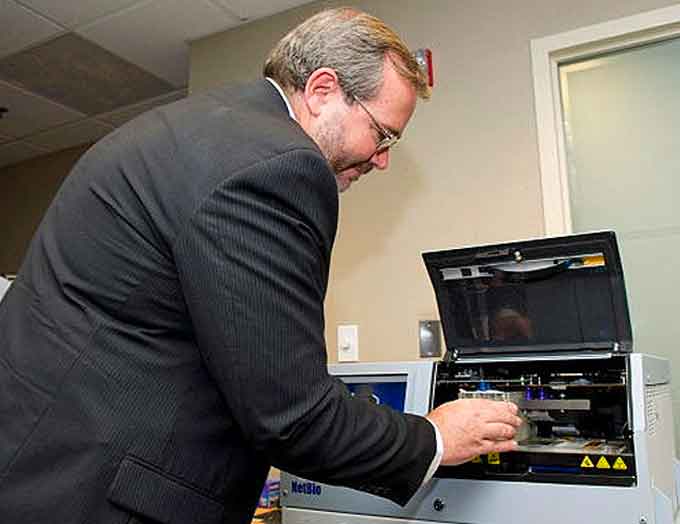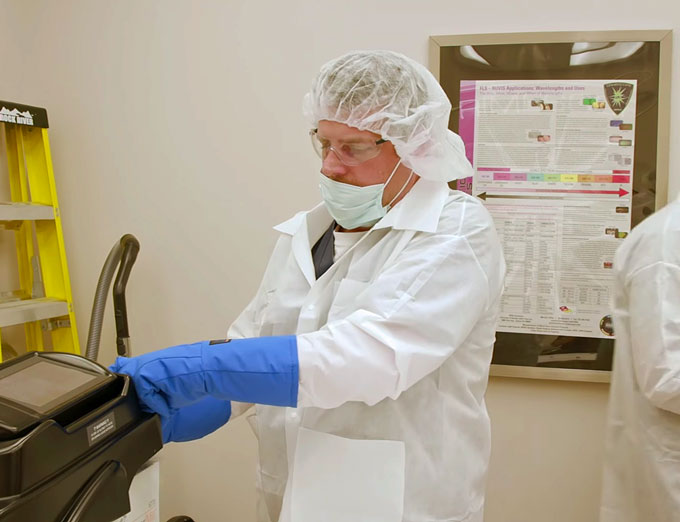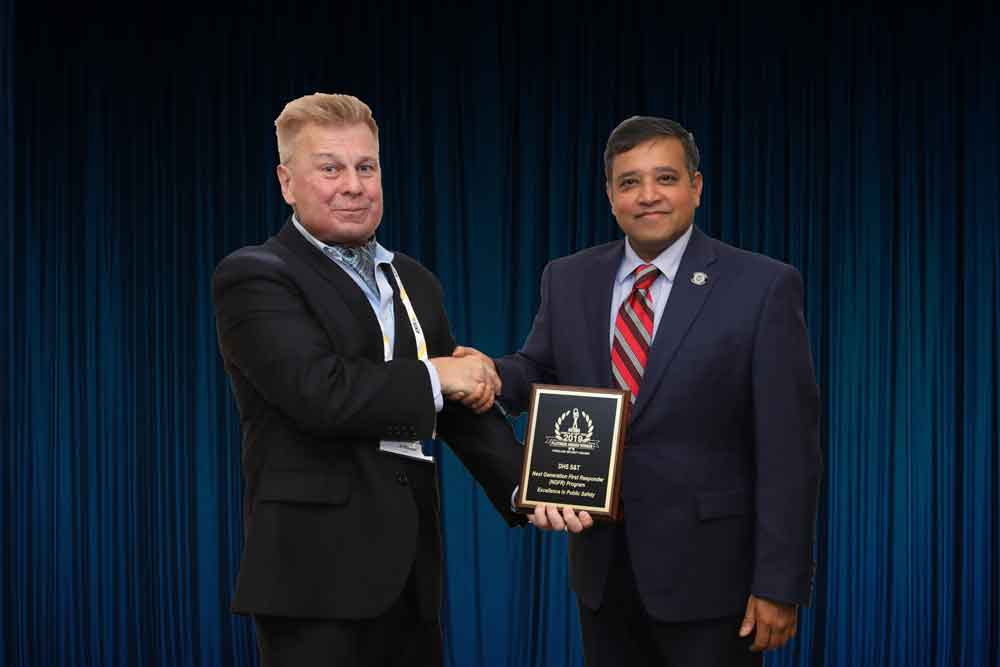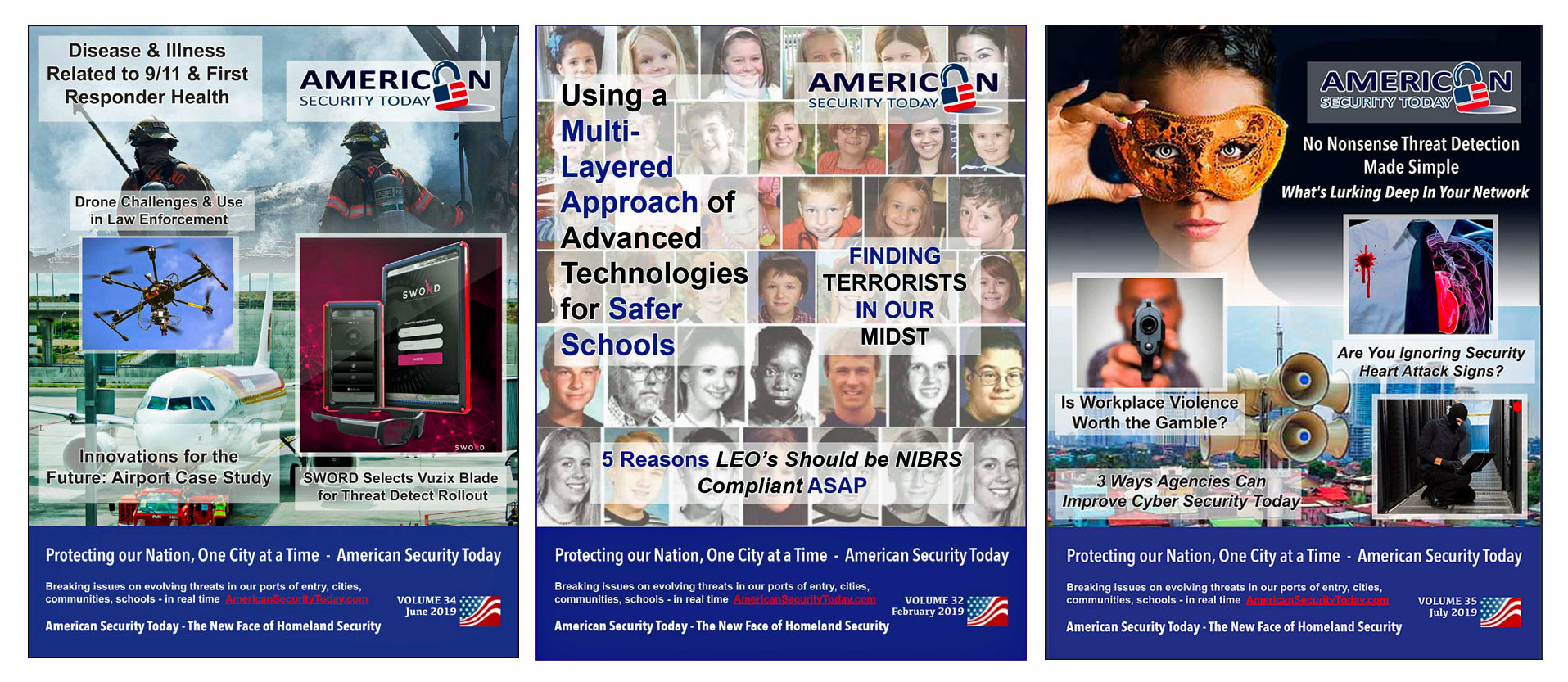
Thirty-four people died in a tragic boat fire which occurred off the coast of Santa Cruz Island, California, on September 2, 2019.
Five injured crew members managed to escape after calling for help, but the intense fire aboard the Conception dive boat left the 34 victims completely unrecognizable.
Thanks to a new technology funded by the Department of Homeland Security (DHS) Science and Technology Directorate (S&T), a Three-Time Award Winner in the 2019 ‘ASTORS’ Homeland Security Awards Program, and developed by the ANDE Corporation, the 33 passengers and one crew member who died were quickly identified.
“The Santa Barbara Sheriff-Coroner relied heavily on a Rapid DNA instrument to identify the victims in 10 days,” explained Chris Miles, the S&T Program Manager who led the S&T Rapid DNA project.
“That is an amazingly fast resolution to the disaster that just wouldn’t have been possible before.”
(Rapid DNA testing helped identify Conception fire victims, and Camp Fire Victims. Courtesy of KSBY News and YouTube. Posted on Sep 6, 2019.)
The Rapid DNA instrument was on loan from another California jurisdiction – the Sacramento County Coroner and one of her deputies brought their own instrument, used last year during the Camp Fire, to help with the Santa Barbara incident.
“It’s so great to see expertise being passed on to other local agencies,” Miles said.

The Rapid DNA instrument, which is the size of a desktop printer, was a result of the DHS S&T Small Business Innovative Research (SBIR) program, which challenges industry to bring innovative homeland security solutions to reality.
DHS sought a technology that can quickly analyze DNA to verify family relationships (kinship) and identify victims of mass casualty events and human trafficking.
The ANDE corporation received an investment of more than $5 million from DHS S&T to develop the Rapid DNA instrument that identifies samples in as little as 90 minutes.
ANDE came up with a portable machine that met the requirements set by SBIR and potential DHS end users.
(ANDE is dedicated to the development and commercialization of Rapid DNA products for human forensic identification, biothreat detection, and clinical diagnostics. Moving DNA analysis from the laboratory to the field will dramatically improve societal safety and health. By reducing crime, exonerating the innocent, monitoring borders, and reuniting families, Rapid DNA represents a fundamental opportunity for the public and private sectors to protect the innocent. Courtesy of ANDE Corporation and YouTube. Posted on Nov 15, 2019.)
“DHS S&T has been instrumental in supporting ANDE’s development of the Rapid DNA technology,” explained Dr. Richard Selden, ANDE’s Founder and Chief Scientific Officer.
“In addition to funding several projects, Chris Miles of S&T worked to include ANDE in a number of mock disaster victim identification exercises—experiences that were invaluable when we initiated our efforts at the Camp Fire disaster.”
The traditional turn-around time for DNA analysis is months or even years.

‘Why?’ wondered Dr. Richard Selden before he founded the ANDE Corporation.
Due to backlog, results can take from six to 24 months.
“I created the term ‘Rapid DNA’ as shorthand for a system that would allow nontechnical users to generate DNA identifications outside the lab in less than two hours,” said Selden.
He founded ANDE Corporation in 2004 specifically to develop Rapid DNA.
“When I met Chris Miles more than 10 years ago, he believed in Rapid DNA, pursued it, found funding for it, and advocated for it.”
“Chris believed Disaster Victim Identification would be a great application for Rapid DNA. All that played a major role in our success.”

From the onset of its conception, Rapid DNA was designed to preserve the privacy of the tested.
The instrument analyzes only the so-called ‘junk DNA’ – small chromosomal regions that do not code for genes.
This DNA, scientifically known as ‘short tandem repeats,’ does not reveal individual characteristics like hair and eye color, or medical conditions.
The Rapid DNA technology has already been tested in a number of mock disaster victim identification exercises.
It has also been used in real disasters, such as the 2018 Camp Fire in California (the ANDE team identified 85% of the victims), providing closure to families and loved ones.
Rapid DNA identified the victims of the Boat Fire
 Before going home after assisting with the Camp Fire, the ANDE team trained several employees from the Sacramento Coroner’s Office and left behind one Rapid DNA instrument to help them identify unidentified remains from other cases.
Before going home after assisting with the Camp Fire, the ANDE team trained several employees from the Sacramento Coroner’s Office and left behind one Rapid DNA instrument to help them identify unidentified remains from other cases.
The same instrument was used for the recent boat fire.
“Hopefully, God willing, there aren’t many large-scale disasters, but if you are prepared, that means you can use this technology for disasters and for one-off cases,” Selden said.
“And that is exactly what happened with the boat fire – Sacramento County was prepared.”
“After we did the identifications in the Camp Fire, most coroners in the state of California knew what we did,” said Sacramento County Coroner Kimberly Gin.
“So, when the Santa Barbara Conception Boat Fire happened, Santa Barbara asked us to come down.”
(The Sacramento County Coroner headed down to assist in the task of identifying bodies. Courtesy of CBS Sacramento and YouTube. Posted on Sep 2, 2019.)
On the same day the fire started, Gin and her deputy coroner drove their morgue van with the Rapid DNA instrument to Santa Barbara.
They started running samples as soon as victims were retrieved from the water. Within two days, all victims were recovered except one.
To identify a person, his or her DNA must be compared to a blood relative’s. The last victim was finally found on September 11. Between September 2 and 11, all 34 victims were identified with Rapid DNA.
“We were able to bring closure to families the same day they gave samples,” Gin said.
“It was really gratifying to see. Our goal was to empower people in agencies around the country to be able to do this work themselves,” said Selden.
“I think it was one of the fastest, if not the fastest, identification of mass casualty victims in history.”
(“The success of the identification process was due in large part to the assistance of the Sacramento County Coroner Kimberly Jin, and the rapid DNA technology of the ANDE Corporation,” Santa Barbara Sheriff Bill Brown said in a press conference about the latest on the dive boat fire. Courtesy of ABC 10 and YouTube. Posted on Sep 12, 2019.)
Future applications of Rapid DNA
More and more jurisdictions are following the lead of these California agencies in using Rapid DNA for disaster victim identification.
The disaster victim identification application of Rapid DNA is further being improved by adding a uniform data system for holding victims’ and relatives’ information so that relatives not present in the area can provide samples remotely.
S&T has been working with the American Society of Crime Laboratory Directors (ASCLD), which represents 600 State and local criminal laboratories, for using Rapid DNA on a daily basis to identify criminals and then use it during regional disasters.
S&T and ASCLD are working to train labs to use Rapid DNA in their own jurisdictions.

“As there are 19,000 police departments across the U.S., the applications of Rapid DNA are huge,” said Dr. Ray Wickenheiser, Director of the New York State Police Crime Laboratory System.
“DNA data is more objective than an eyewitness. Further improving Rapid DNA is even better because it strengthens public safety or identifies the victims to bring closure in the event of a disaster.”
Some states are already using Rapid DNA for criminal cases. Since 2018, Utah has been using Rapid DNA for many of their criminal cases such as identifying suspects and excluding non-suspects, and Kentucky is using it to help with sexual assault cases.
“Rapid DNA provided closure quickly to many grieving families for both the Camp Fire and the Boat Fire in California,” said Miles.
“We hope more and more jurisdictions will start using it for their disaster or criminal related cases.”
DHS S&T Honored for Fourth Consecutive Year in Annual ‘ASTORS’ Excellence and Government Awards
Department of Homeland Security (DHS) Science and Technology (S&T) Directorate
-
-
Excellence in Public Safety
-
Next Generation First Responder (NGFR) Program
-
The Next Generation First Responder (NGFR) Program works with first responders across the country to ensure the technology they use while responding to an emergency keeps them better protected, connected and fully aware.
-

DHS S&T National Urban Security Technology Laboratory (NUSTL)
-
Excellence in Public Safety
-
Responder RAD Preparedness
-
Responder RAD Preparedness – DHS Science and Technology Directorate, National Urban Security Technology Laboratory, in partnership with FEMA & the Department of Energy, & National Nuclear Security Administration (NNSA) provides guidance and exercises for first responders and emergency managers on how to plan for the first minutes of an radiological dispersal device, or “dirty bomb,” detonation.

DHS S&T Office of Mission and Capability Support
-
Excellence in Public Safety
-
The FOVEA (Forensic Video Exploitation and Analysis) Tool Suite
-
The FOVEA (Forensic Video Exploitation and Analysis) Tool Suite is an add-on suite of analytic tools for the forensic review of video in large-scale surveillance systems, developed by MIT Lincoln Laboratory under the DHS S&T Office of Mission and Capability Support (MCS) Surface Transportation Explosive Threat Detection (STETD) Program for Complex investigations.

The 2019 ‘ASTORS’ Awards Program surpassed expectations with a record number of nominations received from industry leaders and government agencies, and drew over 200 attendees to the ‘ASTORS’ Awards Presentation Banquet – an exclusive gourmet luncheon and networking opportunity which filled to capacity, before having to turn away late registrants.

The event featured an impassioned and compelling keynote address by William J. Bratton, former police commissioner of the New York Police Department (NYPD) twice, the Boston Police Department (BPD), and former chief of the Los Angeles Police Department (LAPD), as he walked attendees through 50 years of American policing history, the impacts on the communities, and the evolution of critical communication capabilities in our post 9/11 landscape.

Commissioner Bratton, one of the world’s most respected and trusted experts on risk and security issues and Executive Chairman of Teneo Risk a global advisory firm, was recognized as the ‘2019 ‘ASTORS’ Person of the Year’ for his Lifetime of Dedication and Extraordinary Leadership in Homeland Security and Public Safety.
Why the 2019 ‘ASTORS’ Homeland Security Awards Program?

American Security Today’s comprehensive Annual Homeland Security Awards Program is organized to recognize the most distinguished vendors of physical, IT, port security, law enforcement, and first responders, in acknowledgment of their outstanding efforts to ‘Keep our Nation Secure, One City at a Time.’
Over 200 distinguished guests representing Federal, State and Local Governments, and Industry Leading Corporate Firms, gathered from across North America, Europe and the Middle East to be honored among their peers in their respective fields which included:
- The Drug Enforcement Administration (DEA)
- National Center for Missing and Exploited Children (NCMEC)
- United States Marine Corps
- The Federal Protective Service (FPS)
- Argonne National Laboratory (ANL)
- United States Postal Inspection Service
- DHS S&T
- United States Marshals Service (USMS)
- The Port Authority of New York & New Jersey Police (PAPD)
- The Department of Justice (DOJ)
- The New York State Division of Homeland Security & Emergency Services (NYS DHSES)
- United States Border Patrol
- AlertMedia, Ameristar Perimeter Security, Attivo Networks, Automatic Systems, Bellevue University, BriefCam, Canon U.S.A., CornellCookson, Drone Aviation, FLIR Systems, Hanwha Techwin, HID Global, IPVideo Corp., Konica Minolta Business Solutions, LenelS2, ManTech, Regroup Mass Notifications, SafeLogic, SolarWinds, Senstar, ShotSpotter, Smiths Detection, TCOM LP, Trackforce, Verint, and More!
Why American Security Today?
The traditional security marketplace has long been covered by a host of publications putting forward the old school basics to what is Today – a fast changing security landscape.
The traditional security marketplace has long been covered by a host of publications putting forward the old school basics to what is Today – a fast changing security landscape.
American Security Today is uniquely focused on the broader Homeland Security & Public Safety marketplace with over 75,000 readers at the Federal, State and local levels of government as well as firms allied to government.
American Security Today brings forward a fresh compelling look and read with our customized digital publications that hold readers eyes throughout the story with cutting edge editorial that provides solutions to their challenges.
Harness the Power of the Web – with our 100% Mobile Friendly Publications

The AST Digital Publications is distributed to over 75,000 qualified government and homeland security professionals in federal, state and local levels.
‘PROTECTING OUR NATION, ONE CITY AT A TIME’
AST Reaches both Private & Public Experts, essential to meeting these new challenges.
Today’s new generation of public safety and security experts need real-time knowledge to deal with domestic and international terrorism, lone wolf attacks, unprecedented urban violence, shifts in society, culture and media bias – making it increasingly difficult for Homeland Security, Law Enforcement, First Responders, Military and Private Security Professionals to implement coordinated security measures to ensure national security and improve public safety.
These experts are from Government at the federal, state and local level as well as from private firms allied to government.
AST provides a full plate of topics in our AST Monthly Magazine Editions, AST Website and AST Daily News Alerts, covering 23 Vital Sectors such as Access Control, Perimeter Protection, Video Surveillance/Analytics, Airport Security, Border Security, CBRNE Detection, Border Security, Ports, Cybersecurity, Networking Security, Encryption, Law Enforcement, First Responders, Campus Security, Security Services, Corporate Facilities, and Emergency Response among others.
AST has Expanded readership into integral Critical Infrastructure audiences such as Protection of Nuclear Facilities, Water Plants & Dams, Bridges & Tunnels, and other potential targets of terrorism.
Other areas of concern include Transportation Hubs, Public Assemblies, Government Facilities, Sporting & Concert Stadiums, our Nation’s Schools & Universities, and Commercial Business Destinations – all enticing targets due to the large number of persons and resources clustered together.
To learn more about the 2019 ‘ASTORS’ Homeland Security Award Winners solutions, Be on the lookout for the 2019 ‘ASTORS’ Championship Edition Magazine – the Best Products of 2019 ‘A Year in Review’.
The ‘ASTORS’ Champion Edition is published annually in December and includes a review of programs, feature details on many of the winning firms, video interviews and more.
To Learn More about advertising opportunities with American Security Today, please contact Michael Madsen, AST Publisher at mmadsen@americansecuritytoday.com.
AST strives to meet a 3 STAR trustworthiness rating, based on the following criteria:
- Provides named sources
- Reported by more than one notable outlet
- Includes supporting video, direct statements, or photos





















